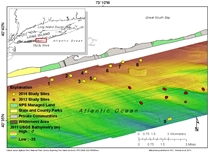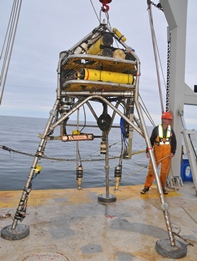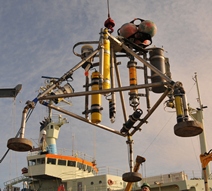Introduction
The U.S. Geological Survey (USGS), in cooperation with scientists from the University of South Carolina and the Woods Hole Oceanographic Institution, is investigating ocean circulation and sediment-transport processes in the coastal waters offshore of Fire Island, New York. This experiment focused on an area near the western end of the island. Instruments were placed mostly at the 10-meter (m) isobath, about 1 kilometer (km) offshore, and were positioned at eight sites along approximately 8 km of the coastline.
There were two intents of the study. The first was to investigate the alongshore variability of the waves as they arrived at the coast. Variations in wave heights and directions along the coast can lead to changes in alongshore sediment-transport patterns and can create regions of erosion and accretion. The second intent was to study the cross-shore variations in sediment transport. A recent sediment budget analysis (Schwab and others, 2013) concluded that a cross-shore sediment flux is required to close the budget and identified that the inner shelf is a likely source. A previous field study in 2012, about 5 kilometers offshore, measured the waves, currents, and sediment dynamics on a series of shoreface-connected sand ridges (fig. 1). These offshore sand ridges extend across the inner continental shelf and connect to the nearshore bar system, oriented obliquely to the coastline. These ridges are on the order of 5 to 10 km long and are spaced several kilometers apart (fig. 1). The USGS mapped these features at high resolution (generally 300 to 325 m apart cross-shore, 5 km apart alongshore) in 2011, providing detailed bathymetry, subsurface structure, and surface texture (Schwab and others, 2013). The ridge field can modify surface waves from storms, causing complex wave patterns along the coastline and influencing sediment-transport and coastal-erosion patterns (Martini and others, 2012).
This study is part of a larger effort by the USGS, in cooperation with the U.S. Army Corps of Engineers and the National Park Service, to study coastal processes on Fire Island. The efforts described here were coordinated with beach surveys, light detection and ranging (lidar), and aerial photography to assess coastal change during winter storms (National Park Service, 2012; Hapke and others, 2013).
The deployment consisted of nine instrumented platforms positioned on the sea floor. Sites 1, 2, 4, 6, 7, and 8 were deployed along the 10-m isobath (fig. 1) to measure ocean circulation and variations of waves along the coast. Sites 3 and 5 were located offshore of sites 2 and 4 to measure changes in the cross-shore direction. Site 9 was located further offshore to measure waves and currents at a deeper location.
Site 2 and site 3 were each populated with high-resolution flow tripods (Flobees; fig. 2) holding similar instrumentation. Measurements that would interfere with sensors on the Flobee were made from a smaller tripod (minipod, fig. 3) deployed alongside the Flobees at site 2 and site 3. At each of the remaining USGS sites a single tripod holding fewer instruments was placed with the primary objective of measuring current speed and direction, temperature, salinity, surface waves, and bottom stress (the force created at the seabed by currents and waves). Surface buoys were deployed at sites 1 through 8 to mark the tripod locations and to serve as platforms for surface measurements. Each of the surface buoys at sites 1, 4, and 8 was outfitted with a suite of meteorological sensors to determine local atmospheric conditions, gradients and forcing. A Datawell Waverider buoy was deployed at site 9. Instruments deployed with each tripod are described in the subsequent sections. The tripods and instrumentation at sites 4 and 5 (fig. 1) were deployed by the Woods Hole Oceanographic Institute. Descriptive information and data from sites 4 and 5 are not included in this report.
This data report presents background information on the impetus for studying coastal change processes in the inner shelf and nearshore area at Fire Island; a description of the field program, including the oceanographic instrumentation used to collect data; and the data-processing and archival techniques used. The edited data are presented in time series plots for rapid visualization of the dataset and in links to data files, which are in the Network Common Data Form (NetCDF) format.
| Click on figures for larger images. |
 |
Figure 1. U.S. Geological Survey (USGS) 2012 and 2014 study sites off Fire Island, New York. Bathymetry is shown in meters (m). National Park Service (NPS) managed land, State and county parks, private communities, and Federal wilderness areas on the barrier islands are indicated on the map. |
 |
Figure 2. A high-resolution flow tripod (Flobee) holding instrumentation to measure flow and sediment resuspension. Photograph by Sandra Brosnahan, U.S. Geological Survey. |
 |
Figure 3. Minipods holding instrumentation to measure the seabed surface and current velocity profiles were deployed at sites 2 and 3. Photograph by Sandra Brosnahan, U.S. Geological Survey. |
